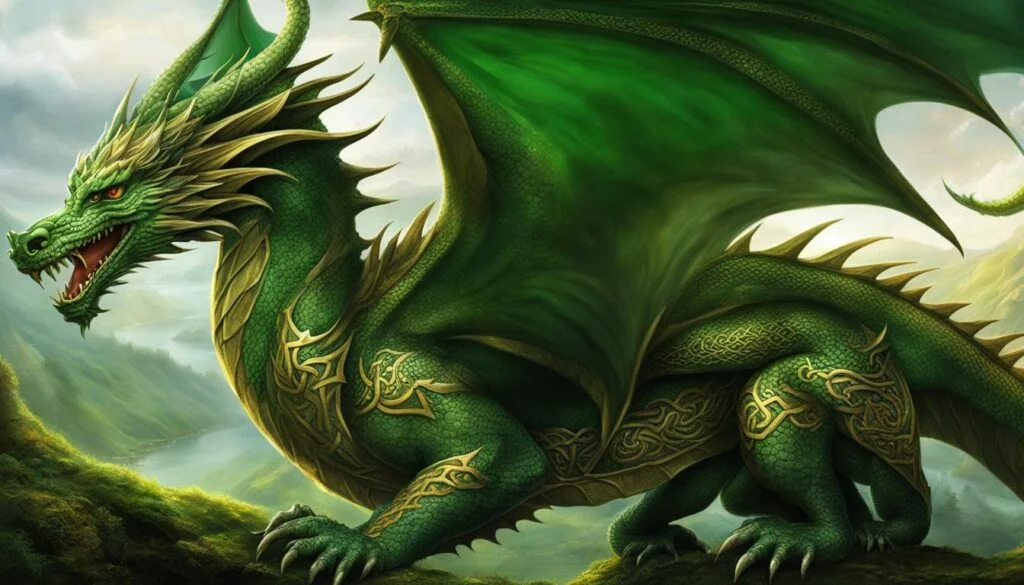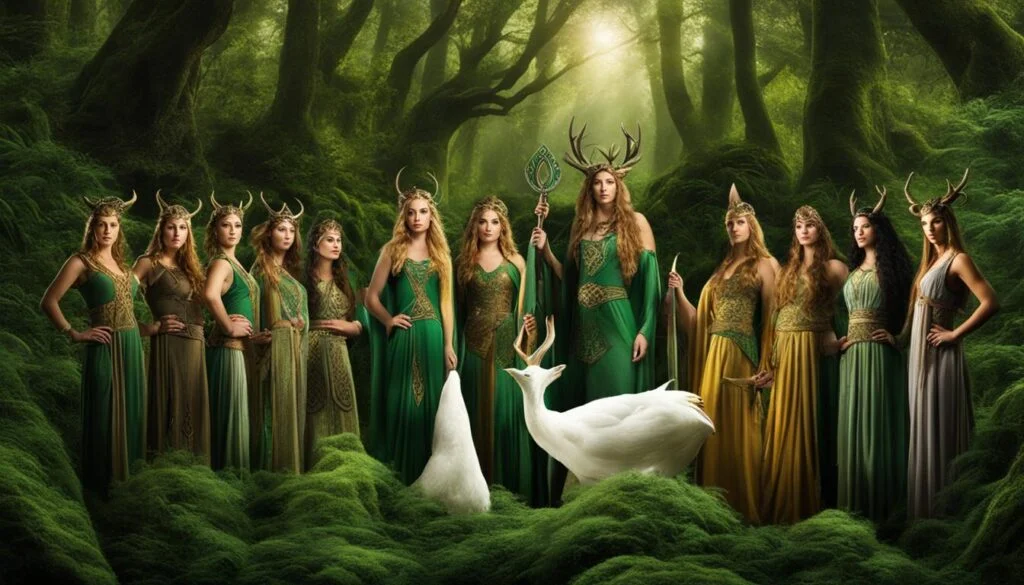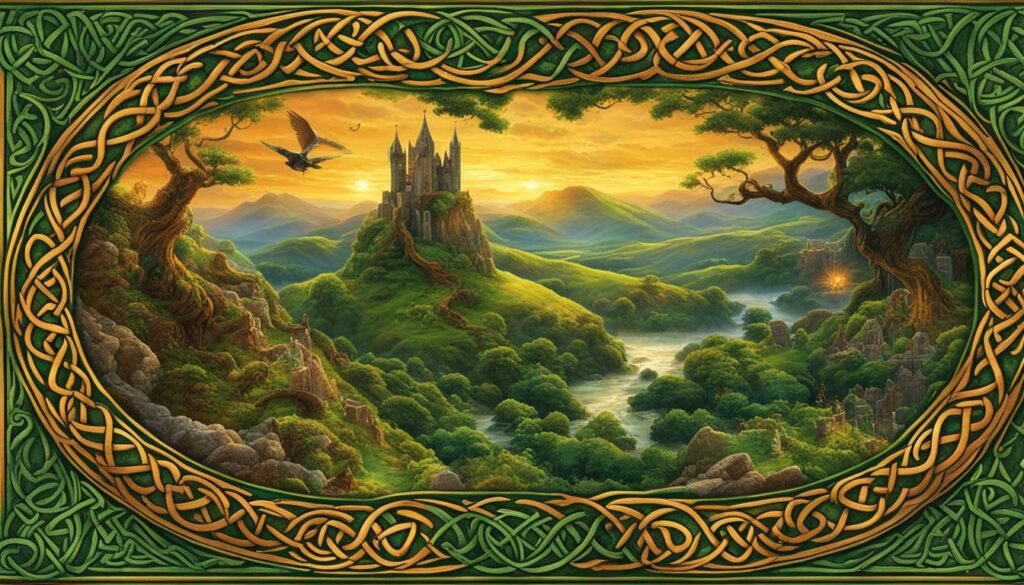Welcome to our exploration of Celtic mythology and its enchanting creatures. Today, we delve into the captivating world of dragons in Celtic folklore. Dragons have long been revered and feared in various cultures worldwide, and the Celts were no exception. So, let us embark on a journey to uncover the truth behind the existence of dragons in Celtic mythology.
Key Takeaways:
- Dragons hold a significant place in Celtic culture and mythology.
- They symbolize strength, power, and guardianship.
- Celtic dragons are associated with protecting the earth and its treasures.
- Dragons can be found in Celtic legends, artwork, and symbols.
- While their appearance may differ, their significance remains unquestionable.
The Role of Dragons in Celtic Culture
Dragons have always held a significant place in Celtic culture, representing power, strength, and wisdom. They are deeply rooted in the beliefs and mythology of the Celts, serving as symbols of bravery and guardianship. In Celtic folklore, dragons are often associated with gods and are believed to be protectors of the earth and its inhabitants.
The symbolism of dragons in Celtic culture can be seen in various forms of art, such as flags, shields, and ships. These representations reflect the Celts’ reverence for these mythical creatures and their desire to embody their qualities of courage and resilience. One notable figure in Celtic mythology, King Arthur, is said to have dreamed of dragons, symbolizing his connection to their power and the ultimate battles he faced.
According to Celtic beliefs, dragons are the guardians of the universe’s secrets and treasures. They are associated with higher ideals rather than earthly riches, symbolizing the pursuit of knowledge and enlightenment. The ancient Celtic druids considered dragons as wise creatures and followed their mythical paths to gain wisdom and a deeper understanding of the world’s natural laws. These paths, often referred to as “dragon paths,” were sacred and believed to be magical points of connection between the earthly realm and the Celtic gods.
The Significance of Celtic Dragon Symbolism
- Dragons represent power, strength, and wisdom in Celtic culture.
- They serve as symbols of bravery and guardianship.
- Celtic artwork often features dragons, reflecting the Celts’ reverence for these mythical creatures.
- The ancient Celtic druids believed that dragons held secrets and followed their paths to gain wisdom.
- Dragon symbolism embodies the pursuit of knowledge and enlightenment in Celtic mythology.
Druids and Dragons
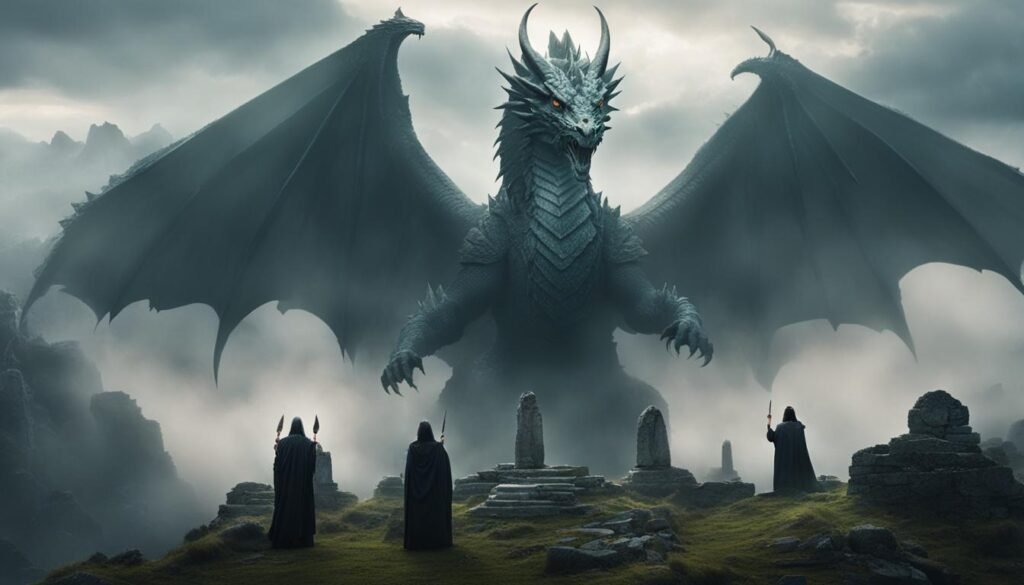
In ancient Celtic mythology, the druids played a significant role in the belief and worship of dragons. The druids were the spiritual leaders of the Celtic people, revered for their wisdom and connection to the natural world. They believed that dragons were wise creatures with a deep understanding of the laws governing the universe. As such, they followed the paths of dragons, known as “dragon paths,” to gain knowledge and insight into the mysteries of the world.
These dragon paths were considered sacred places of power and connection between the earthly realm and the Celtic gods. The druids would engage in contemplation and meditation at these sites, seeking to obtain the desired gifts and wisdom from the dragons. It was believed that by connecting with the dragons, the druids could tap into their ancient knowledge and gain a deeper understanding of the world and its workings.
The Wisdom of Dragons
The Celts saw dragons as symbols of wisdom and enlightenment. They believed that the dragons’ association with the gods bestowed upon them a deep understanding of the natural forces and the world’s secrets. The druids sought to tap into this wisdom and incorporate it into their spiritual practices and teachings.
- They believed that the dragons’ knowledge could guide them in making important decisions and solving complex problems.
- Their connection to the dragons allowed them to gain insights into the mysteries of life, death, and the cycles of nature.
- Dragons were revered as guardians of ancient wisdom, and the druids sought their counsel to guide their communities and ensure their prosperity.
Dragon Mythology in Celtic Culture
The belief in dragons and their association with the druids was deeply ingrained in Celtic culture. Dragons were seen as powerful beings with a spiritual essence, closely connected to the land and its people. Their presence in Celtic mythology symbolized the importance of wisdom, protection, and harmony with nature.
- Dragons were often depicted in Celtic artwork, showcasing their significance in the culture’s visual representation.
- They were seen as guardians of sacred places and treasures, ensuring their safety and preserving the balance of the natural world.
- The druids’ connection to dragons highlighted the spiritual connection between humans and the divine, emphasizing the importance of seeking wisdom and understanding in the world around us.
Celtic Dragon Legends
Celtic mythology is rich with captivating dragon legends that have been passed down through generations. These mythical creatures have fascinated people with their awe-inspiring power and mysterious presence. Here are some of the most renowned dragon legends in Celtic culture:
The Fire-Breathing Dragon in Wales
One famous legend tells of a fire-breathing dragon that terrorized the land of Wales. This fearsome creature was believed to be responsible for the pockets of firedamp gas found underground. The dragon’s fiery breath was said to ignite this gas, resulting in deadly explosions. This captivating tale showcases the ancient Celtic fascination with the power and danger associated with dragons.
Merlin the Magician and His Prophetic Dreams
In Celtic mythology, the mighty magician Merlin is closely associated with dragons. He had prophetic dreams that featured these mythical creatures, symbolizing his deep connection to their power and wisdom. As an iconic figure in Celtic folklore, Merlin’s association with dragons adds an element of mystique and enchantment to the tales of ancient times.
Master Stoorworm – The Mighty Sea Serpent
In Celtic mythology, Master Stoorworm is a fearsome sea serpent known for devouring objects and causing havoc in the waters. This mighty dragon is often portrayed as a symbol of chaos and transformation. Master Stoorworm’s ability to change shape and wreak havoc adds an intriguing aspect to Celtic dragon legends, showcasing their complexity and mythical characteristics.
Celtic Dragon Symbols
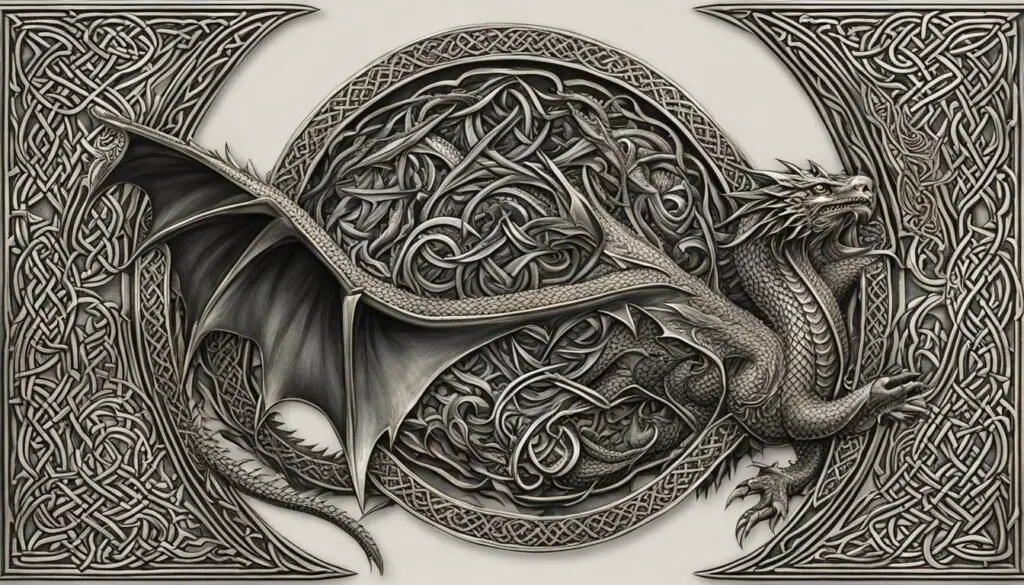
Dragons hold a significant place in Celtic culture, and their symbolism is deeply rooted in Celtic mythology. These powerful creatures are often depicted in intricate artwork, representing various aspects of Celtic beliefs and values. In Celtic culture, dragon symbols represent power, wisdom, and protection.
One of the most iconic Celtic dragon symbols is the intertwined dragon design. The intertwined bodies of the dragons depict the cycle of nature and immortality. This symbolizes the interconnectedness of all things in the Celtic worldview. The dragon’s scale patterns also hold symbolic meaning, representing the power and strength that dragons possess.
Dragon Symbolism in Celtic Culture:
- Power: Dragons are seen as symbols of power and authority among Celtic leaders. They are often associated with rulers and warriors who possess great strength and courage.
- Wisdom: Dragons are known for their wisdom and intellect. In Celtic mythology, they are believed to possess deep knowledge of the universe’s secrets and treasures.
- Protection: Dragons are regarded as guardians in Celtic culture. They protect sacred places, treasures, and even the earth itself. Their presence brings a sense of security and safety.
The use of dragon symbols in Celtic artwork is a testament to their enduring significance in Celtic culture. These symbols can be found on ancient artifacts, such as jewelry, weapons, and carvings. They continue to inspire modern artists and craftsmen who seek to honor and preserve Celtic traditions.
The dragon’s symbolism in Celtic culture transcends time and remains a powerful representation of strength, wisdom, and protection. Its presence in artwork serves as a reminder of the rich mythological heritage that continues to captivate and inspire people today.
Dragons in Celtic Mythology and Christianity
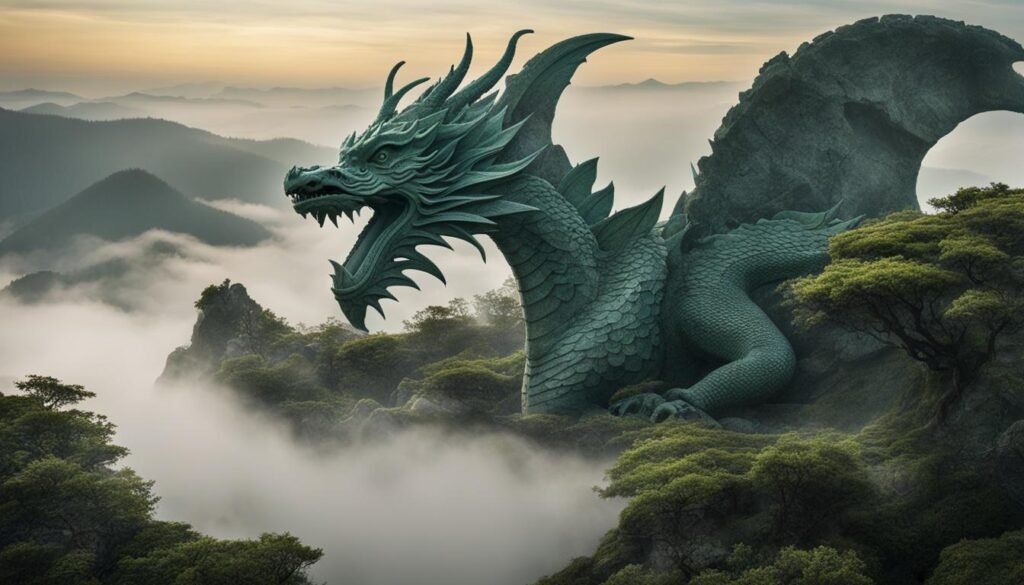
Throughout Celtic mythology, dragons have held a significant place, symbolizing power, wisdom, and guardianship. However, with the introduction of Christianity in Celtic countries, the interpretation of dragons took on a different meaning. Dragons became associated with evil and the Devil, representing trouble, strife, and infertility. Christian interpretations of dragons in Celtic myths portrayed them as malevolent creatures, embodying the power of the Devil. Despite this shift in perception, dragons remained popular in the Celtic revival movement, particularly among historians and craftsmen.
Dragons in Celtic folklore were once seen as mythical beings connected to the gods, serving as guardians of secrets and treasures. These majestic creatures represented higher ideals and protected the Earth and all living beings. However, as Christianity spread, dragons became symbols of evil, reflecting the religious beliefs of the time.
The Influence of Christian Interpretation
The Christian interpretation of dragons in Celtic myths transformed the perception of these creatures. Dragons were no longer seen as powerful beings associated with wisdom and protection but were instead linked to the malevolent forces of the Devil. Despite this transformation, dragons retained their popularity in Celtic art and culture, continuing to captivate the imagination of many.
The Dual Nature of Dragons
While Christianity painted dragons in a negative light, it is important to note the dual nature of these mythical creatures in Celtic mythology. Dragons were once revered for their strength, wisdom, and role as guardians. Their symbolism went beyond material wealth, representing the connection between the earthly realm and the divine. This duality showcases the complexity and rich symbolism associated with dragons in Celtic culture.
Types of Dragons in Celtic Mythology
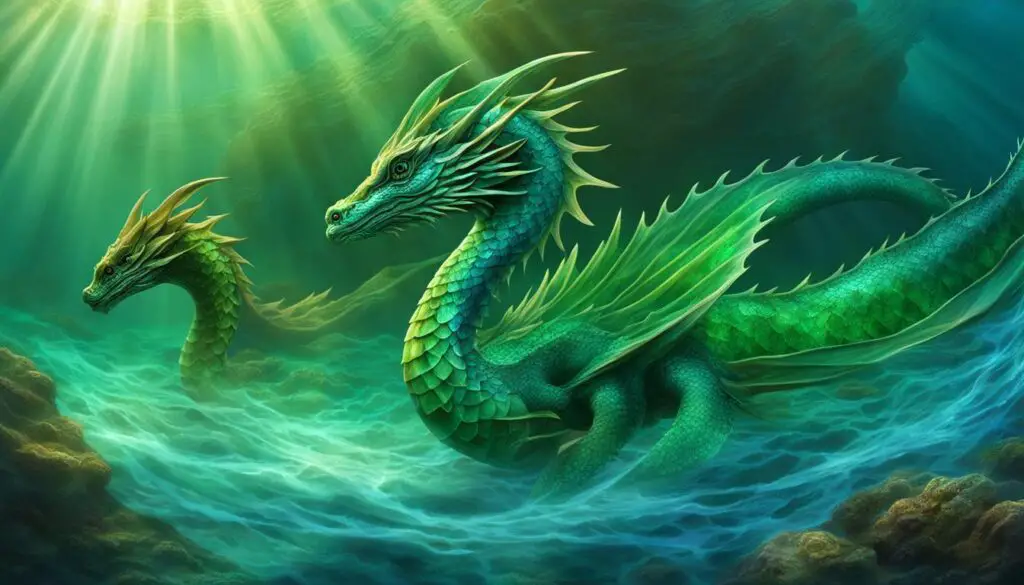
When exploring Celtic mythology, it becomes apparent that dragons hold a significant place in the lore. These powerful creatures come in various forms and are deeply intertwined with the culture and beliefs of the Celtic people. Here, we delve into the different types of dragons present in Celtic mythology, including sea dragons that have a special connection with the Celtic culture.
The Standard Winged Dragon
One of the most common types of dragons in Celtic mythology is the standard winged dragon. This dragon closely resembles the traditional western depiction of dragons, with wings and four legs. It symbolizes power, strength, and often acts as a guardian in Celtic lore. The winged dragon is frequently associated with bravery and is found in various forms of artwork, such as on shields and flags.
Sea Dragons in Celtic Culture
Celtic mythology also features sea dragons, which are believed to dwell in lakes and the sea. These sea dragons come in different variations, ranging from giant wingless serpents to large serpents with wings but no legs. Some famous sea dragons in Celtic culture include the Afang and Addanc, which are associated with Welsh and Irish mythology. These aquatic creatures hold a unique place in Celtic folklore, representing the mysteries and treasures hidden beneath the waves.
Celtic Dragon Variations
In addition to the standard winged dragons and sea dragons, Celtic mythology features other variations of dragons. These variations can be found in different regional myths and legends, each with its distinctive characteristics. While their appearances may differ, these dragons share the common traits of power, wisdom, and protection. They are often seen as guardians of secrets and treasures, as well as symbols of strength and resilience in Celtic culture.
In Celtic mythology, dragons take on various forms, embodying different aspects of power and significance. The presence of these dragons throughout Celtic folklore reflects the deep reverence the Celts held for these creatures and their connection to the natural world. Whether they are standard winged dragons, sea dragons, or other variations, dragons play a vital role in shaping the rich tapestry of Celtic mythology.
The Oilliphéist – Ireland’s Dragons
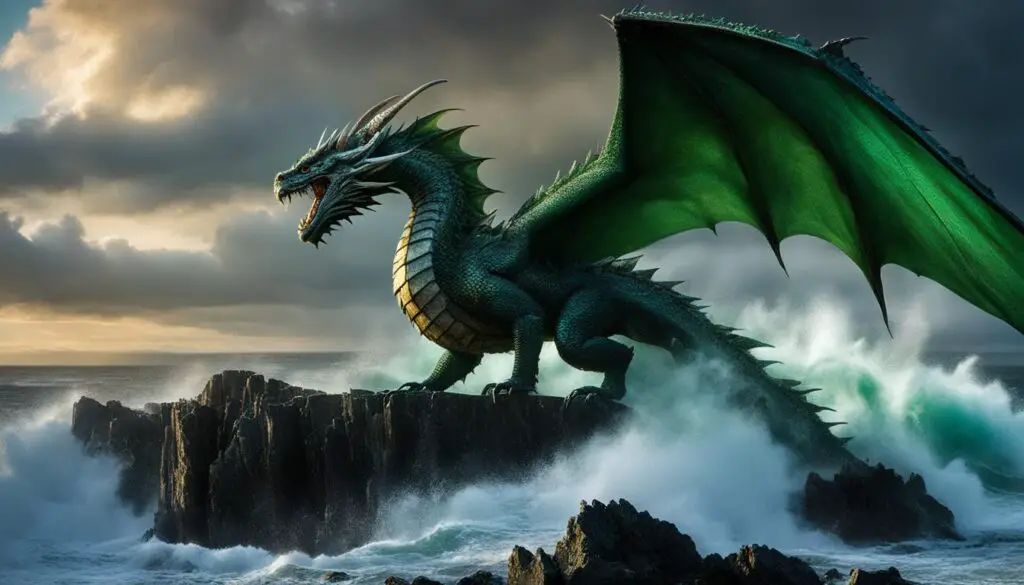
In Irish folklore, the oilliphéist reigns as one of the most fascinating and formidable creatures. These monstrous beings are said to be the closest representation of traditional dragons in Irish mythology. With their immense size and serpentine appearance, oilliphéists are often associated with lakes, where they act as guardians of palaces and fortresses. Legends depict them as fearsome creatures that strike fear into the hearts of all who encounter them.
Among the famous oilliphéists in Irish folklore are Balor of the Evil Eye and Caoránach. Balor, often described as a one-eyed giant, possessed immense power and malevolence. It is said that his gaze alone could cause destruction and chaos. Caoránach, on the other hand, was a monstrous sea serpent, feared for her ability to devour both objects and living beings. These legendary creatures are just a glimpse into the rich and vibrant world of Irish dragon mythology.
Oilliphéist Legends
- The oilliphéist is known for its immense size and serpentine appearance.
- They are associated with lakes and act as guardians of palaces and fortresses.
- Legends depict them as fearsome creatures with immense power and malevolence.
- Balor of the Evil Eye and Caoránach are two famous oilliphéists in Irish folklore.
The Oilliphéist in Irish Folklore
- These monstrous creatures are considered the closest representation of traditional dragons in Irish mythology.
- They strike fear into the hearts of all who encounter them.
- Legends depict them as fearsome creatures that possess immense power.
- They are often associated with lakes and act as guardians of palaces and fortresses.
The Cata – Ireland’s Loch Ness Monster
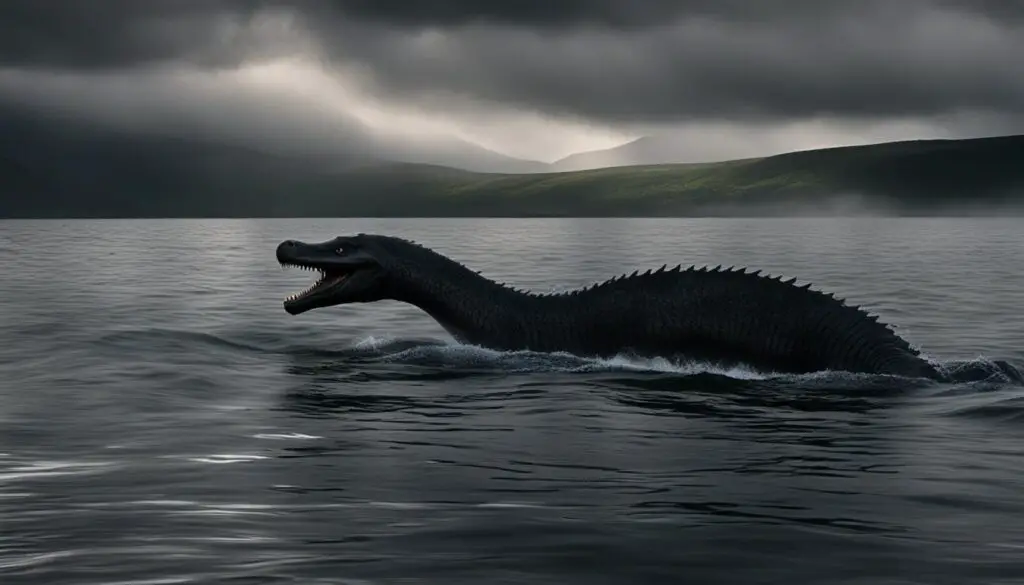
When it comes to legendary water monsters, the first name that often comes to mind is the Loch Ness Monster. However, Ireland also boasts its own elusive creature known as the Cata. This mythical water monster is said to inhabit the River Shannon, the longest river in Ireland, captivating the imagination of both locals and visitors alike.
The Cata is described as a formidable creature with a horse-like head, gleaming eyes, thick claws, and a powerful whale’s tail. Sightings of the Cata have been reported throughout history, adding to the intrigue and mystery surrounding this Irish water monster. The tales and folklore surrounding the Cata have woven it into the fabric of Irish mythology, making it a captivating and enigmatic figure.
Like its Scottish counterpart, the Cata sparks curiosity and speculation. The legends surrounding this ancient creature, along with the numerous eyewitness accounts, have fueled debates and discussions about its existence. While skeptics may question the reality of such a creature, the stories and the sense of wonder they instill in those who hear them continue to endure.
The Elusive Dragons of Irish Mythology
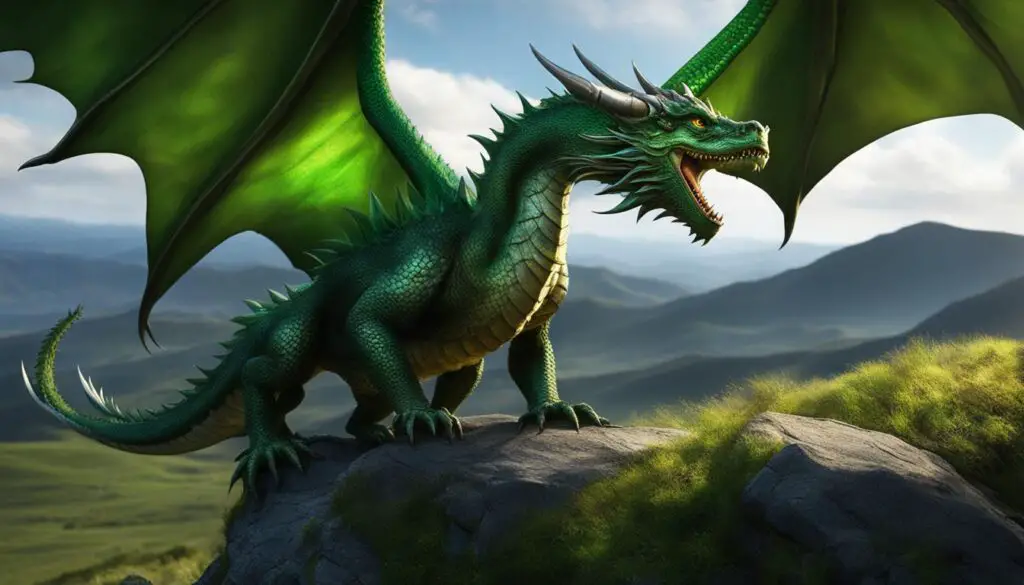
Irish mythology is rich with fascinating creatures, and while dragons may not be the first thing that comes to mind, they do exist within the folklore. These mythical creatures have a mysterious and elusive nature, often associated with the lakes and waters of Ireland. Although they may not fit the traditional image of massive dragons, they possess their own unique power and significance in Irish mythology.
Mysterious Irish Dragons
The dragons in Irish legends are shrouded in mystery, making them all the more intriguing. They are known to guard secrets and treasures hidden beneath the water’s surface, symbolizing the hidden depths of Irish folklore. These dragons are said to possess wisdom that surpasses human understanding, and they are deeply connected to the land and its natural elements.
Dragons in Irish Legends
While the dragons of Irish mythology may not be as well-known as those in other cultures, they play a significant role in the country’s folklore. Stories of these dragons have been passed down through generations, depicting the encounters between heroes and these mythical creatures. These legends often highlight the power and cunning of the dragons, as well as their ability to shape-shift and manipulate their surroundings.
Dragons in Irish Mythology
Dragons exist as part of the rich tapestry of Irish mythology, representing the ancient and mystical aspects of the culture. They evoke a sense of wonder and awe, and their presence in legends serves as a reminder of the hidden wonders that lie within the Emerald Isle. While the true nature of these dragons may forever remain a mystery, their influence on Irish folklore and imagination is undeniable.
Conclusion
In conclusion, dragons have played a significant role in Celtic mythology and folklore. While they may not be depicted in the same way as dragons in other cultures, they are revered as powerful beings symbolizing strength, wisdom, and guardianship. Celtic culture holds dragons in high regard, associating them with bravery and protection.
Throughout Celtic legends and stories, dragons are often portrayed as the guardians of secrets and treasures, defending the earth and all living beings. They are deeply intertwined with the Celtic identity, appearing on flags, shields, and in artwork as symbols of power and wisdom.
Although the arrival of Christianity brought a different interpretation of dragons, with them being associated with evil and the Devil, dragons remain popular in the Celtic revival movement. Today, dragons continue to captivate our imagination and intrigue us with their mystical presence in Celtic mythology.
FAQ
Are dragons considered mythical creatures in Celtic folklore?
Yes, dragons are considered mythical creatures in Celtic folklore and play a significant role in Celtic culture.
What is the role of dragons in Celtic culture?
Dragons in Celtic culture are associated with strength, power, and bravery, often symbolizing guardianship and protection.
Did Celtic druids have a connection with dragons?
Yes, Celtic druids believed in the wisdom of dragons and followed their paths to gain knowledge and understanding of the world.
Are there any famous dragon legends in Celtic mythology?
Yes, there are several famous dragon legends in Celtic mythology, including the fire-breathing dragon in Wales and the sea serpent known as the Master Stoorworm.
How are dragons depicted in Celtic artwork?
Dragons are often depicted in Celtic artwork with intertwined bodies, representing the cycle of nature and symbolizing power and wisdom.
How did the interpretation of dragons in Celtic mythology change with the introduction of Christianity?
The interpretation of dragons in Celtic mythology changed with the introduction of Christianity, with dragons being associated with evil and the Devil.
What are the different types of dragons in Celtic mythology?
There are two main types of dragons in Celtic mythology: the standard winged dragon and the sea dragon, which can be a giant serpent or a serpent with wings.
What is the oilliphéist in Irish mythology?
The oilliphéist is considered the closest thing to a traditional dragon in Irish mythology, known for its immense size and serpentine appearance.
Is there a legendary monster similar to the Loch Ness Monster in Irish mythology?
Yes, the Cata is a legendary monster in Irish mythology often compared to the Loch Ness Monster, said to dwell in the River Shannon.
Are there dragons in Irish mythology, despite the presence of other mischievous creatures?
Yes, dragons exist in Irish mythology and are often associated with lakes and water, guarding secrets and treasures.


